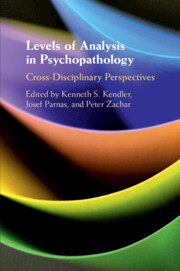Book contents
- Levels of Analysis in Psychopathology
- Advance Praise for Levels of Analysis in Psychopathology
- Levels of Analysis in Psychopathology
- Copyright page
- Contents
- Figures
- Tables
- Contributors
- Preface
- General Introduction
- Part I Neuroscience, Mechanisms, and RDoC
- Part II Phenomenology, Biological Psychology, and the Mind–Body Problem
- Section 4
- Section 5
- Section 6
- 16 Introduction
- 17 Phenomenology of a Disordered Self in Schizophrenia: Example of an Integrative Level for Psychiatric Research
- 18 Who Is the Psychiatric Subject?
- Section 7
- Part III Taxonomy, Integration, and Multiple Levels of Explanation
- Index
- References
18 - Who Is the Psychiatric Subject?
from Section 6
Published online by Cambridge University Press: 02 April 2020
- Levels of Analysis in Psychopathology
- Advance Praise for Levels of Analysis in Psychopathology
- Levels of Analysis in Psychopathology
- Copyright page
- Contents
- Figures
- Tables
- Contributors
- Preface
- General Introduction
- Part I Neuroscience, Mechanisms, and RDoC
- Part II Phenomenology, Biological Psychology, and the Mind–Body Problem
- Section 4
- Section 5
- Section 6
- 16 Introduction
- 17 Phenomenology of a Disordered Self in Schizophrenia: Example of an Integrative Level for Psychiatric Research
- 18 Who Is the Psychiatric Subject?
- Section 7
- Part III Taxonomy, Integration, and Multiple Levels of Explanation
- Index
- References
Summary
This commentary on Parnas and Zandersen reinforces their view about scientific reductionism and their insistence on the importance of a phenomenology of the subjective life for diagnosis and explanation. This “phenomenal ontology” includes experiential structures that involve embodiment, temporality, intentionality, selfhood, and intersubjectivity. A phenomenological account of such factors can counter the lack of specificity about self-related phenomena in the DSM. The vignettes they provide point to a rich complexity in the subject’s situation involving a variety of different dimensions or variables related to the self, and disruptions or anomalies across a pattern of aspects, and not just with respect to the minimal level of experience. The full picture of the self, implicit in the clinical vignettes, involves the recognition of a dynamically structured self-pattern of the many variables that make up one’s life. Such a focus on a self-pattern, however, undermines thinking in terms of explanatory levels.
- Type
- Chapter
- Information
- Levels of Analysis in PsychopathologyCross-Disciplinary Perspectives, pp. 228 - 232Publisher: Cambridge University PressPrint publication year: 2020



